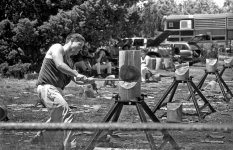ChrisN
Striving
Chris,
Remember the, 'I am lazy bit'? I tend to avoid complications if at all possible.
For 1 or 2 rolls of 35mm film(24 or 36 exposures makes no difference in my experience), I use 500ml of solution in the Jobo 1520, always 500ml never less. With only 5ml of Rodinal required, there is not sense of economy in using less. I have no discernible differences in 1 or 2 rolls in the tank as long as you DO NOT TOUCH the tank after the initial 1 minute of inversions. When I say 'DO NOT TOUCH', I mean DO NOT TOUCH! After 1 minutes of slow in inversions and 3 hearty thumps to dislodge the air bubbles, the tank is not moved, vibrated, pushed, it is not touched, especially if you only have one roll in the tank!
Why... because apparently Rodinal in high dilutions will develop to exhaustion and not over-develop as long as there is no new developer introduced to the emulsion. So whether you have 1 or 2 roll in the tank, if the tank is not touched or moved in way for the 60 minutes, the developed exhausted on the film even though there may be fresh developer elsewhere in the tank. So it is vitally important to keep the solution still, and I could always see a slight difference in the negatives if the tank was bumped or somehow moved so the developer flowed slightly in the tank.
I also use 500ml of 1:125 Rodinal with 1 roll of 120 or 220 in the Jobo 1520 tank. If I have lots of rolls of film to develop, I will use my Jobo tank that holds 5 rolls of 35mm or 3 rolls of 120/220 in 2 litres of solution.
One other thing I have found that while temperature is relatively unimportant, within reason, it is important to have the solution at ambient temperature including the water baths. I found that by starting out with lower temperature than ambient, as the solution rises in temperature while standing, this causes the solution to circulate around the tank which is natural result of convection.
I do not know the technical reason that stand development does or does not work, nor do I really care. I am only reporting on my experience after more than 50 rolls of film over the past 2 months.
I will let the photographs do the talking...
Got it! 5ml in 500ml of water. I'll try that tonight with a roll of expired Kodak Hawkeye surveillance film I shot today. If it comes out I'll post the results!









